Dredgers for cleaning water bodies
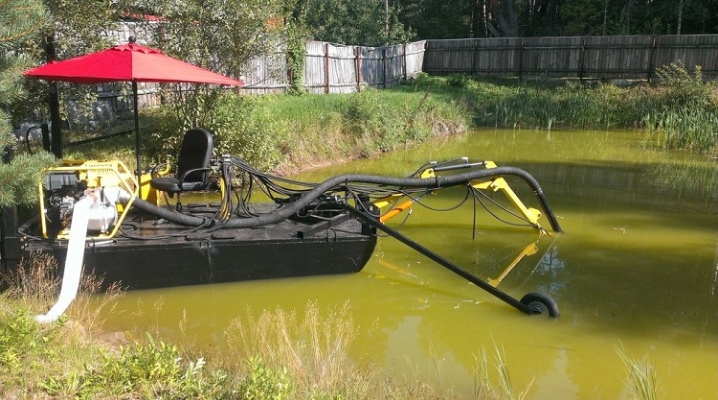
A comfortable summer vacation in a country house is inextricably linked with the opportunity to plunge into your own reservoir. Unfortunately, sooner or later all water bodies become clogged and therefore need special cleaning and deepening of the bottom. A practical and effective solution to this problem will be the use of a dredger.

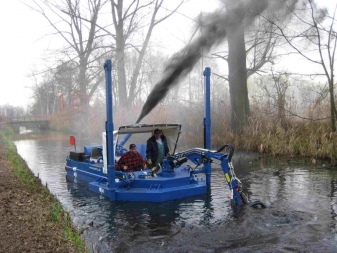
What it is?
A dredger is a floating vehicle, the main purpose of which is to pump silted soil from the bottom of a reservoir to the shore. This is a popular setting for quickly and efficiently removing all sludge deposits. Such systems have become widespread when performing work on cleaning natural or artificial reservoirs, sewer installations and a small deepening of the bottom.
The mechanism of any dredger has two functional units:
- main unit - a mechanism for soil sampling, pipelines, a powerful pump and installation for transporting sludge pulp;
- auxiliary unit - secondary pumps, a lifting and lowering mechanism, an electrical power supply system, a safety module, a control mechanism, devices for measuring and monitoring, a fire fighting system, heating and ventilation devices, communication devices.
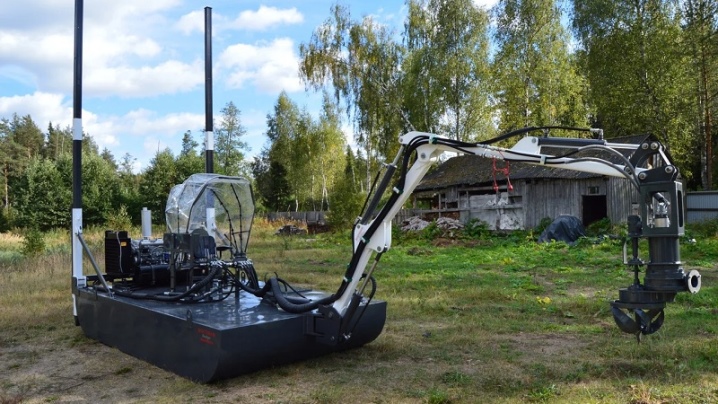
Description of species
Dredgers are presented in a wide variety of models, they are classified according to different characteristics.
In accordance with the performance parameters, there are:
- especially small - less than 50 m³ / h;
- small - 50-200 m³ / h;
- medium - 200-500 m³ / h;
- large - 500-1000 m³ / h;
- extra-large - more than 1000 m³ / h.

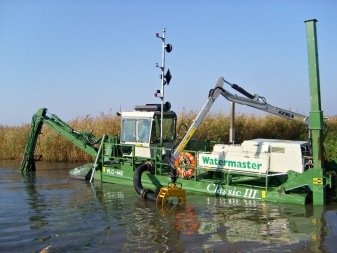
By design parameters:
- monolithic;
- collapsible.
By type of control:
- remote control;
- on electronic control;
- on manual control.
In addition, each type of dredger can have its own power supply system, equipment placement parameter, transportation features and the number of pumps for the collection of sludge pulp. Models can provide cabins for the user.

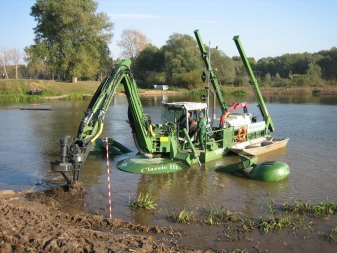
The most widespread are diesel dredgers. They are used in the case when the reservoir is overflowing with polluting elements or if the waterways have become impassable. These systems are used to clean farm lagoons, treatment plant storage ponds, and any commercial pond. Diesel units are presented in a variety of modifications, allowing for soil sampling at a depth of 5-6 m. Excavator power varies from 75 to 325 hp. with., and the power of the pumps allows you to pump out from 30 to 120 cubic meters of pollution per hour.
For difficult working conditions, it is better to give preference electric dredgers. They are optimal for the collection of bottom sediments in precipitation ponds, as well as other technical reservoirs. Multifunctional dredgers-excavators are used to perform fundamental works.
Such installations specialize not only in cleaning, but also in coastal rehabilitation, dam and embankment maintenance.
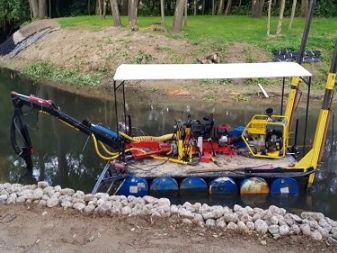
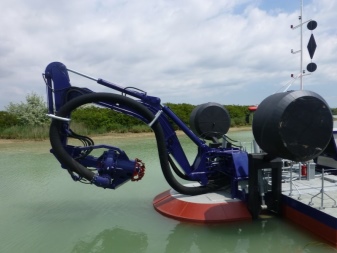
Indispensable for collecting floating debris from the surface of the water skimmer... This device can collect a large amount of garbage up to 100 cm in diameter. Such products are mobile in water, they are easily transported along the shore, and the operation of the installation is based on the use of environmentally friendly technologies. In addition, immediately after switching on, the unit reaches its maximum performance.
For cleaning private ponds, they usually use mini-installations... The advantages of such equipment are that it can be used on such waters, where access of larger equipment is difficult. Due to its compact size and sufficient productivity, it is used on ponds and lakes with a length of several hectares. Such installations are often used to restore abandoned beaches and create comfortable recreation areas.
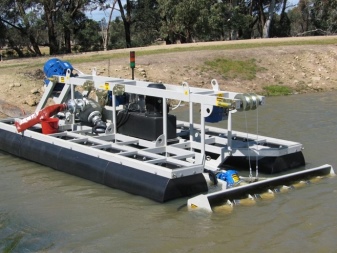

Popular manufacturers
- "Crab". The equipment is manufactured in Vologda. This is one of the most compact models with small folded dimensions, it is easily transported in a regular "Gazelle". Has a productivity ranging from 15 to 30 m³ / h. The cost is about 200 thousand rubles.
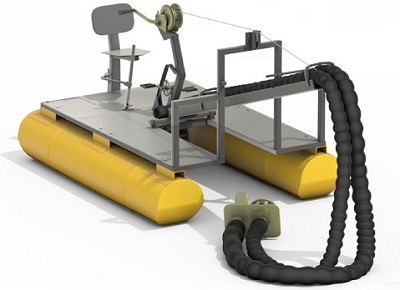
- The dredger has similar characteristics "Neptune".

- "Gudgeon". Equipment produced in Yaroslavl. It differs in a pontoon base, therefore it is more often used for industrial cleaning of ponds. The weight of the installation is almost 1.5 tons, so specialized equipment is required to move it. The most widespread "Gudgeon" received when cleaning reservoirs, in which it has its own parking lot. Hourly productivity is high - up to 200 m³. The price is 750-850 thousand rubles.
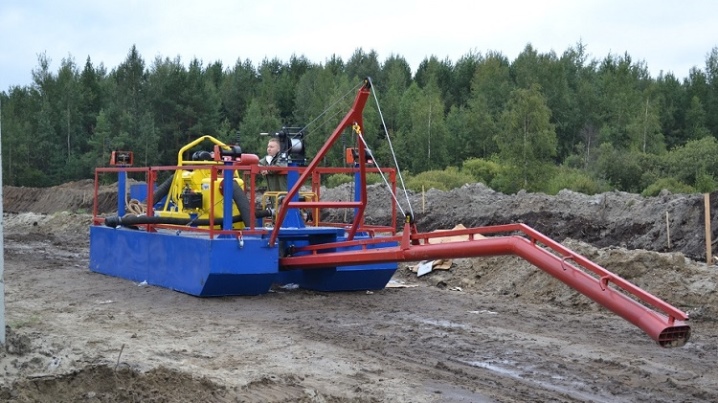
- "Piranha". This dredger is manufactured in the USA, it was there that residents of small settlements began to use it to get rid of sand and bottom silt caused by the current. The base of the dredger is a catamaran, where all the necessary working equipment is located. The unit is equipped with a gasoline engine for free movement in the reservoir. Piranha is recognized as the best solution for owners of private lakes and ponds. The capacity is 15 m³ / h - enough to completely clean a small area near the pier or wash a small beach in a few hours. Installation cost - 600 thousand rubles.
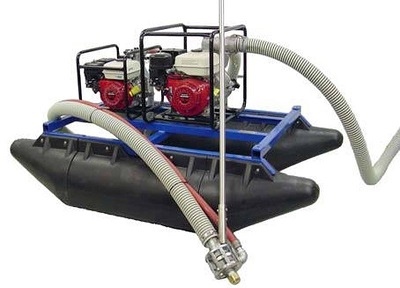
Terms of use
It is necessary to resort to cleaning the reservoir in the following cases.
- When the shade and degree of transparency of the water changes - usually it becomes a consequence of oversaturation with biogenic microorganisms. In addition, a significant amount of suspension from clay and fine sand leads to turbidity.
- Excessive growth of algae or reeds - the accumulation of shoots makes the reservoir shallow, as a result, the water in it quickly warms up, and this stimulates the active growth of all kinds of vegetation.
- Pungent odor becomes a consequence of the active reproduction of fungi and pathogenic bacteria in water bodies.
It is best to carry out cleaning work in May, at a time when the flowering of vegetation in the reservoir is just beginning. The optimal frequency of manipulations is 1 year. For self-cleaning of small private ponds and lakes, mini-dredgers are usually used.
Despite their compact size, they are equipped with a rather powerful pump, so they are able to quickly and efficiently collect any bottom sediments.
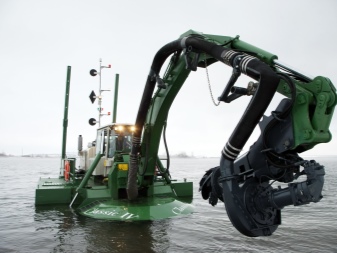

The process of operation of all types of dredgers is based on a single principle:
- first, calculations are performed, which take into account the feed rate of the bottom mixture, as well as the general parameters of the pipe passability;
- then the pump is lowered to the bottom of the pond, pumping water into it;
- then starting the engine and pumping out all the air from the suction tube;
- due to the formed vacuum, water and sludge are drawn inward;
- the collected mixture is pumped to the shore or collected in the hold.
After completing the cleaning procedure, it will take another 3-4 months for the mud to settle. When the water returns to its transparency, fish can be launched into the pond if desired. Pond cleaning is the recommended procedure. With excessive pollution, the ecosystem is disturbed.
In addition, the need for cleaning is due to the need to maintain the aesthetic appearance of the pond. Agree, it will be much more pleasant for everyone to relax on the shore of a clean water body, and not to sit near a sewage pit.

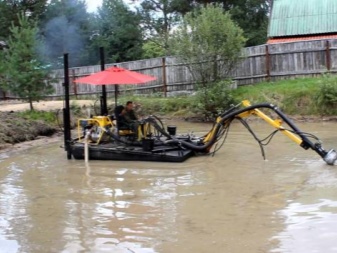






























































The comment was sent successfully.